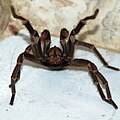Tarantula
(Redirected from Tarantulas)

A tarantula in its natural habitat | |
| Scientific classification | |
| Kingdom | |
| Phylum | Arthropoda |
| Class | |
| Order | |
| Family | |
| Genus | ' |
| Species | ' |
| Binomial name | |
| Binomial authority | |
| Synonyms | |
The tarantula is a group of large and often hairy spiders belonging to the family Theraphosidae. Tarantulas are found in a wide range of environments around the world, particularly in tropical, subtropical, and desert regions. Despite their fearsome appearance and reputation, tarantulas are generally harmless to humans, with bites that are usually no worse than a bee sting in terms of toxicity.
Description
Tarantulas vary greatly in size, color, and behavior, depending on the species. They can range in size from as small as a fingernail to as large as a dinner plate when including their leg span. The body of a tarantula is divided into two main parts: the cephalothorax and the abdomen. They have eight legs, two pedipalps for manipulating food, and chelicerae equipped with fangs that inject venom into their prey.
Habitat and Distribution
Tarantulas inhabit a variety of environments. Some species prefer underground burrows, while others are arboreal, living in trees. Their distribution spans across the Americas, Africa, Asia, and Australia. Each species has adapted to its specific environment, from rainforests to deserts.
Diet
Tarantulas are primarily nocturnal hunters, preying on insects and other small animals. Larger species can even prey on small birds, lizards, and rodents. They rely on ambush and pursuit to catch their prey, using their venom to subdue it.
Reproduction
Tarantula reproduction involves a male depositing sperm into a female's reproductive tract. The female then lays eggs in a silk cocoon and guards them until they hatch. The number of offspring can vary greatly, with some species producing hundreds of spiderlings.
Conservation
While many tarantula species are common and have stable populations, others are threatened by habitat destruction, the pet trade, and climate change. Conservation efforts are in place for some of the more vulnerable species to ensure their survival.
In Culture
Tarantulas have a significant presence in popular culture, often depicted in movies, literature, and as exotic pets. Despite their portrayal as dangerous creatures, they are generally shy and reclusive, posing little threat to humans.
Transform your life with W8MD's budget GLP-1 injections from $125.
W8MD offers a medical weight loss program to lose weight in Philadelphia. Our physician-supervised medical weight loss provides:
- Most insurances accepted or discounted self-pay rates. We will obtain insurance prior authorizations if needed.
- Generic GLP1 weight loss injections from $125 for the starting dose.
- Also offer prescription weight loss medications including Phentermine, Qsymia, Diethylpropion, Contrave etc.
NYC weight loss doctor appointments
Start your NYC weight loss journey today at our NYC medical weight loss and Philadelphia medical weight loss clinics.
- Call 718-946-5500 to lose weight in NYC or for medical weight loss in Philadelphia 215-676-2334.
- Tags:NYC medical weight loss, Philadelphia lose weight Zepbound NYC, Budget GLP1 weight loss injections, Wegovy Philadelphia, Wegovy NYC, Philadelphia medical weight loss, Brookly weight loss and Wegovy NYC
|
WikiMD's Wellness Encyclopedia |
| Let Food Be Thy Medicine Medicine Thy Food - Hippocrates |
Medical Disclaimer: WikiMD is not a substitute for professional medical advice. The information on WikiMD is provided as an information resource only, may be incorrect, outdated or misleading, and is not to be used or relied on for any diagnostic or treatment purposes. Please consult your health care provider before making any healthcare decisions or for guidance about a specific medical condition. WikiMD expressly disclaims responsibility, and shall have no liability, for any damages, loss, injury, or liability whatsoever suffered as a result of your reliance on the information contained in this site. By visiting this site you agree to the foregoing terms and conditions, which may from time to time be changed or supplemented by WikiMD. If you do not agree to the foregoing terms and conditions, you should not enter or use this site. See full disclaimer.
Credits:Most images are courtesy of Wikimedia commons, and templates, categories Wikipedia, licensed under CC BY SA or similar.
Translate this page: - East Asian
中文,
日本,
한국어,
South Asian
हिन्दी,
தமிழ்,
తెలుగు,
Urdu,
ಕನ್ನಡ,
Southeast Asian
Indonesian,
Vietnamese,
Thai,
မြန်မာဘာသာ,
বাংলা
European
español,
Deutsch,
français,
Greek,
português do Brasil,
polski,
română,
русский,
Nederlands,
norsk,
svenska,
suomi,
Italian
Middle Eastern & African
عربى,
Turkish,
Persian,
Hebrew,
Afrikaans,
isiZulu,
Kiswahili,
Other
Bulgarian,
Hungarian,
Czech,
Swedish,
മലയാളം,
मराठी,
ਪੰਜਾਬੀ,
ગુજરાતી,
Portuguese,
Ukrainian
Contributors: Prab R. Tumpati, MD












